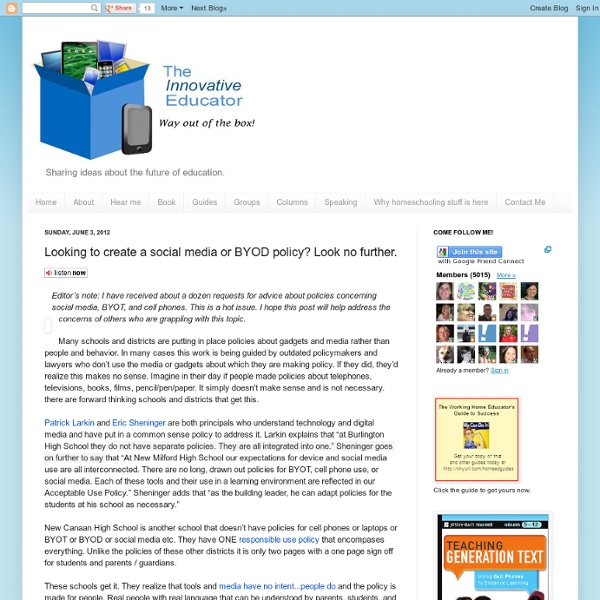



Forum: It’s Personal – Personalized Learning for Students and Educators Key Questions Right Now: What practical steps can educators take to personalize learning for their students in 2012–13, and how can technology facilitate this? The Big Picture: How close are we to being able to realize the dream of personalized, differentiated, passion-based learning for educators and students, and what still has to happen to make this fully real? Getting Started Video: Watch the Forum Users Guide for a tutorial on how to get started. Notice: Forums have been archived! If you would like a copy of the Forum Archive please contact us..
Trustees Recently we presented an in-service to the Board of Education on The Digital Foundations of Teaching and Learning: Preparing for a Future that is Here Today. An abbreviated slideshare is included below. We also showed some fabulous video clips but we will save those for another post. The presentation was anchored in a metaphor and image of fire. “Technology IS just a tool, like a stick. In Surrey, we are using technology to TRANSFORM teaching and learning. We identified the Shifts that are Impacting Education globally, some of which include: 1. These trends are shaping the transformation of how we teach and how students learn. The BC Ministry of Education describes it as “Learning Empowered by Technology.” The wise use of technology for learning was endorsed in a research paper that examined high performing districts across Canada. So how are we doing that as a district? Here are some of the fire starters we have initiated in the district:
Teacher-Librarians My staff describe it as a “year of wonder.” Sometimes we call it a tsunami and just want to ride the wave without crashing. Other times we refer to it as a fire beginning to flame across the district. We consider it as seeding pockets of innovation we want to take root and spread organically as connected and rooted networks. Innovative Learning Designs (Phase 1)A year ago we announced the 18 schools that were awarded grants as part of the Innovative Learning Designs schools (ILD), Phase 1. The Engaging the Digital Learner SeriesWe realized that as educators we needed to find a way to engage our learners. The Digital Discovery Series This series ran parallel to the one above. Cadres of Digital ChampionsWe created Cadres of Digital Champions (a team of three educators at every school). Core Digital Coaches From the above group, we asked for volunteers that wanted to become a core team of Digital Coaches to provide support to their larger group. How have others viewed these initiatives?
Personalize Learning My Book Order "Teaching Generation Text" at this link. What's it about? TEACHING GENERATION TEXT looks at breaking the ban that exists in today’s schools and bridging the digital divide with cell phones, the most ubiquitous and overlooked learning device in American households. Discover how to stop fighting and start embracing cell phones as powerful learning aids that engage learners in fun and relevant ways. From policy to parent permission, from discipline to classroom management with a wealth of exciting new tools, featuring lesson plans and research-based teaching strategies TEACHING GENERATION TEXT provides everything educators need to harness the power of cells today! Learn how I became interested in using mobile devices for learning even though they were banned in my district, here. This video features me and my co-author sharing our thoughts about using cell phones in education. Want to know more about Teaching Generation Text? The secret is out! This is the first guide I created.
Symposium on Personalized Learning On August 4-6, 2010, more than 150 invited education leaders convened in Boston around the need for the systemic redesign of our K-12 education system to one that is centered on the personalized learning needs of each student. Attendees identified the top 10 essential elements and policy enablers. Now available are a report of these findings as well as an archive of the presentations, including session summaries and videos, student videos, and attendee poll results. November, 2010: Education Leaders Identify Top 10 Components of Personalized Learning. Innovative Policies, Developer Content and Data Tools are Key, According to Education Officials at SIIA Mobile Learning Forum Thu, 20 Mar 2014 15:24 SIIA this week hosteda successful meeting with education policy makerstoenhance dialogue withdevelopers of moble learning and other educational technologies. Frequently Asked Questions about Student Data Privacy Fri, 13 Dec 2013 15:19 Thu, 05 Dec 2013 19:50
Using TPACK as a Framework for Tech PD, Integration and Assessment. Henrico County Schools System has adopted the TPACK as the Framework for professional development and 21st Century Learning in the Henrico County Schools System. Henrico County is one of the largest and earliest districts to pioneer and implement a one-to-one initiative. They have adopted this model as its conceptual framework to guide their progress towards the 21st Century Learning. See How Henrico County School District Incorporates Technology into Learning.Henrico 21 Overview from HCPS Instructional Technology on Vimeo. To see more videos visit this link. Below are some essential pieces toward meeting their vision. The TPACK ModelThe TPACK Model was created in response to the need to provide a framework around the important pieces of innovating learning with a focus on Technology, Pedagogy, and Content Knowledge. This is a diagram of the model. Assessment Tools Technology Infused LessonsThe teachers write lessons incorporating the elements of the TPACK model.